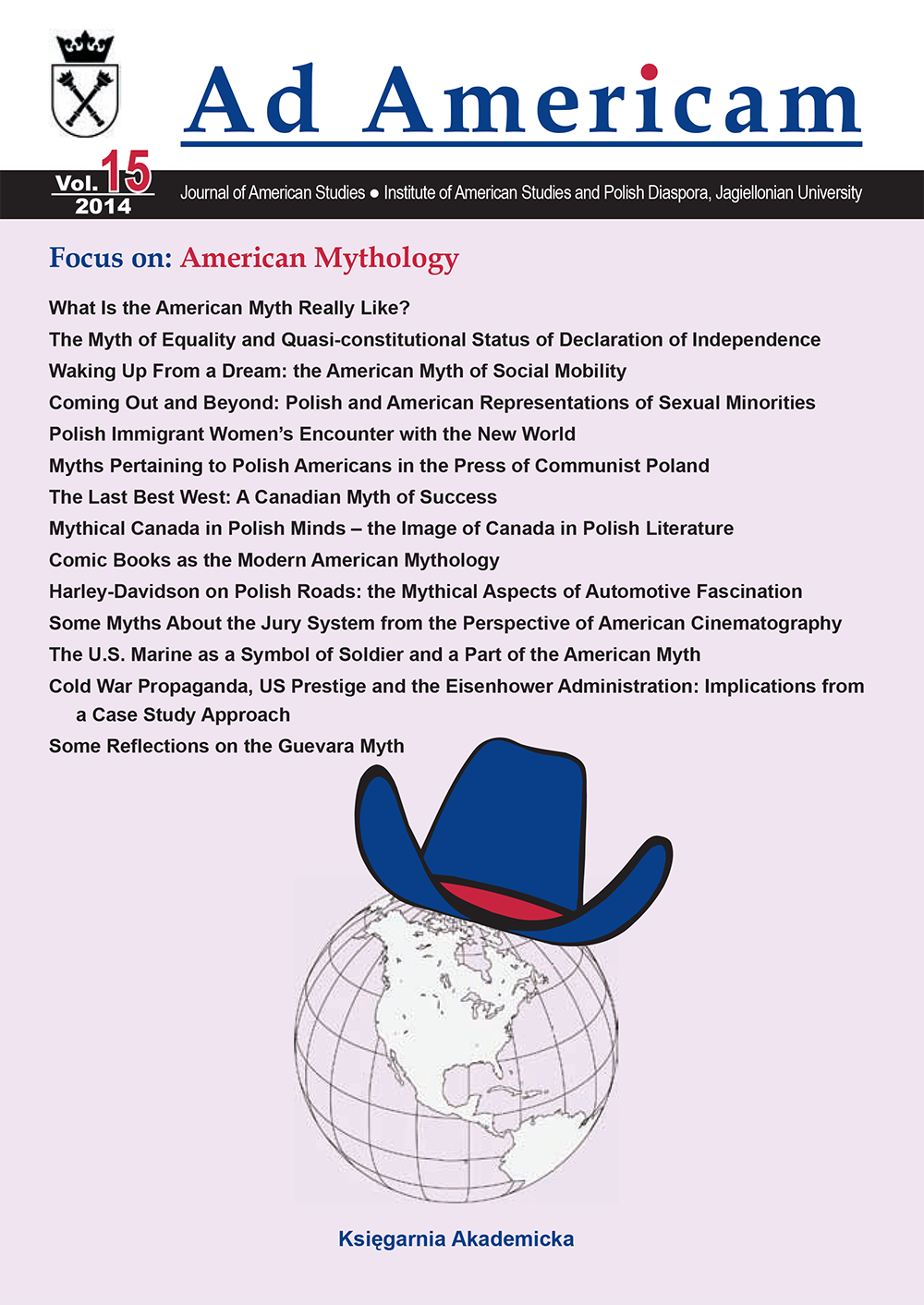Some Myths about the Jury System from the Perspective of American Cinematography
DOI:
https://doi.org/10.12797/AdAmericam.15.2014.15.12Abstract
The popularity of the jury in the US legal system makes it, on the one hand, an attractive research subject for many specialists in American Studies, and, on the other, a source of inspiration for Cultural Studies. Many films and TV series create general myths about the structure, operation and character of jury trials in the United States. Among the most typical myths are: the 12‑member requirement, the necessity to achieve unanimous verdicts, and vast politicization of the voir dire procedure. The topic of law and culture is very attractive among American scholars, as both areas have a significant impact on the everyday life of not only American society, but also other societies around the world. Facing the complexity of popular legal culture, the purpose of the article is to confront the most popular myths of jury trials shaped by specific works of American cinematography, such as 12 Angry Men, The Verdict, Runaway Jury, Murder One, and Law and Order. The most common misunderstandings of how the jury system works shall be revealed by a brief analysis of Supreme Court precedents referring to jury functioning in the contemporary US legal system.
References
Abramson, Jeffrey. “The Unanimous Verdict Should Be Retained.” The Jury System. Ed. Mary E. Williams. San Diego: Greenhaven Press, 1997: 28‑37.
Asimow, Michael, and Shannon Mader. Law and Popular Culture. A Coursebook. New York: Peter Lang, 2013.
Babcock, Barbara A., and Ticien M. Sassoubre, “Deliberation at 12 Angry Men”. 82 Chicago‑Kent Law Review 82, 2007: 633‑642.
Bartlett, Robert. Trial by Fire and Water. The Medieval Judicial Ordeal. Oxford: Clarendon Press, 1986.
Bodenhamer, David J., Ely, James W. The Bill of Rights in Modern America. Revised and Expanded. Bloomington: Indiana University Press, 2008.
Brenner, Suzan W., and Lori E. Shaw, Federal Grand Jury. A Guide to Law and Practice. Indiana: Thomson/West, 2006.
Caenegem, Raoul C. van. The Birth of English Common Law. New York: Cambridge University Press, 1988. DOI: https://doi.org/10.1017/CBO9780511607974
Cohan, William D. The Price of Silence: The Duke Lacrosse Scandal, the Power of the Elite, and the Corruption of Our Great Universities. New York: Simon and Schuster, 2014.
Devlin, Patrick. Trial by Jury. London: Stevens and Sons Ltd., 1966.
Doyle, Charles. “The Federal Grand Jury.” The Federal Grand Jury. Ed. Lyn Farrel. New York: Novinka Books, 2002: 1‑45.
Fairfax, Roger A., Jr. Grand Jury 2.0. Modern Perspectives on the Grand Jury. Durham Carolina Academic Press, 2011.
Ferguson, Andrew G. Why Jury Duty Matters. A Citizen’s Guide to Constitutional Action. New York: New York University Press, 2013.
Fukurai, Hiroshi, and Richard Krooth. Race in the Jury Box. Affirmative Action in Jury Selection. Albany: State University of New York Press, 2003. DOI: https://doi.org/10.1353/book4721
Gorgoglione, Robert D. Essays on Foundations of American Constitutional Government: By the Chains of the Constitution. Bloomington: Xlibris Corporation, 2011.
Grabowski, Marcin, Krzysztof Kozak, and Gyorgy Toth. The United States as a Divided Nation. Past and Present. Frankfurt am Main: Peter Lang, 2014. DOI: https://doi.org/10.3726/978-3-653-04189-7
Hamilton, Alexander, James Madison, and John Jay. Federalist Papers. Ed. Clinton Rossiter. New York: Mentor Book, 1961. DOI: https://doi.org/10.4159/harvard.9780674332133
Harris Pole for American Bar Association. Jury Service: Is Fulfilling Your Civic Duty a Trial?. July 2004. Web. 15 September 2014. http://www.americanbar.org/content/dam/aba/migrated/2011_build/american_jury/harris_poll_report.authcheckdam.pdf.
Jarrow, Gail. The Printer’s Trial. The Case of John Peter Zenger and the Fight for Free Press. Honesdale: Calkins Creek, 2006.
Jonakait, Randolph N. The American Jury System. New Haven: Yale University Press, 2003.
Jonakait, Randolph N. “The Supreme Court Allows Smaller Juries.” The Right to a Trial by Jury. Ed. Robert Winters. San Diego: Greenhaven Press, 2005: 66‑71.
Jost, Kenneth. “The Jury System. An Overview.” The Jury System. Ed. Mary E. Williams. San Diego: Greenhaven Press, 1997: 9‑18.
King, Nancy J. “The American Criminal Jury.” World Jury Systems. Ed. Neil Vidmar. Oxford: Oxford University Press, 2000: 93‑124. DOI: https://doi.org/10.1093/acprof:oso/9780198298564.003.0003
Laidler, Paweł. “Proceduralna i materialna właściwość prawa: XIV poprawka i jej rola w rozwoju amerykańskiego konstytucjonalizmu.” Konstytucjonalizm w państwach anglosaskich. Ed. Andrzej Zięba. Kraków: Wydawnictwo UJ, 2013: 411‑430.
Landsman, Stephan. “The American Civil Jury.” World Jury Systems. Ed. Neil Vidmar. Oxford: Oxford University Press, 2000: 381‑403. DOI: https://doi.org/10.1093/acprof:oso/9780198298564.003.0011
Levy, Leonard W. “The Medieval Origins of Trial by Jury.” The Right to a Trial by Jury. Ed. Robert Winters. San Diego: Greenhaven Press, 2005: 18‑30.
Lilly, Graham C. “The Decline of American Jury”. 72 University of Colorado Law Review 72, 2001: 1‑35.
Litan, Robert E., ed. Verdict: Assessing the Civil Jury System. Washington D.C.: Brookings Institute, 1993.
Moore, Lloyd E. The Jury. Tool of Kings, Palladium of Liberty. Cincinnati: W.H. Anderson Company, 1973.
National Center for State Courts. Web. 15 September 2014. http://www.ncsc.org.
Saks, Michael J. Jury Verdicts. The Role of Group Size and Social Decision Rule. Lexington: D.C. Heath and Company, 1977.
Scott, Kyle. Dismantling American Common Law. Liberty and Justice in Our Transformed Courts. Lanham: Lexington Books, 2007.
Shapiro, Fred R., ed. Oxford Dictionary of Legal Quotations. Oxford: Oxford University Press, 1993.
Solomon, Jason M. “The Political Puzzle of the Civil Jury”. 61 Emory Law Journal 61, 2012: 1331‑1395.
Spooner, Lysander. An Essay on the Trial by Jury. New York: Da Capo Press, 1971.
Tanzer, Jacob. “The Majority Verdict Should be Adopted.” The Jury System. Ed. Mary E. Williams. San Diego: Greenhaven Press, 1997: 24‑27.
Tocqueville, Alexis, de. Democracy in America. Ed. Richard D. Heffner. New York: Mentor Book, 1984.
Vidmar, Neil. “Historical and Comparative Perspective.” World Jury Systems. Ed. Neil Vidmar. Oxford: Oxford University Press, 2000: 1‑52. DOI: https://doi.org/10.1093/acprof:oso/9780198298564.003.0001
Downloads
Published
Issue
Section
License
Copyright (c) 2014 Paweł Laidler

This work is licensed under a Creative Commons Attribution-NonCommercial-NoDerivatives 4.0 International License.






